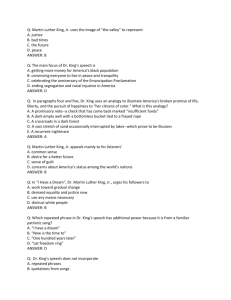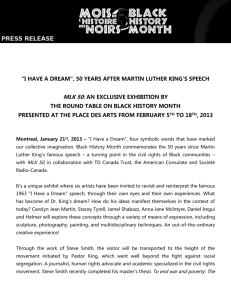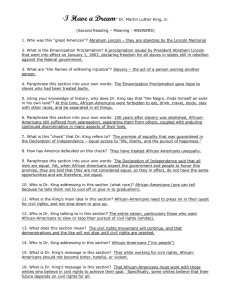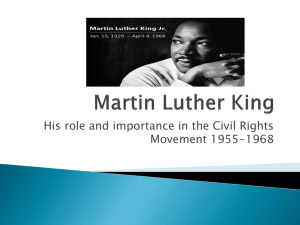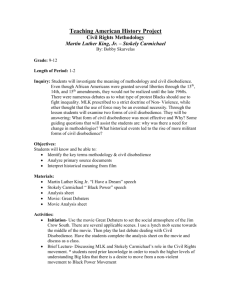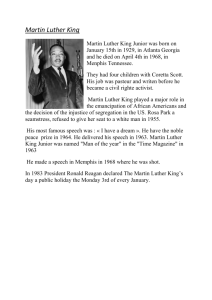UNIT 1
advertisement
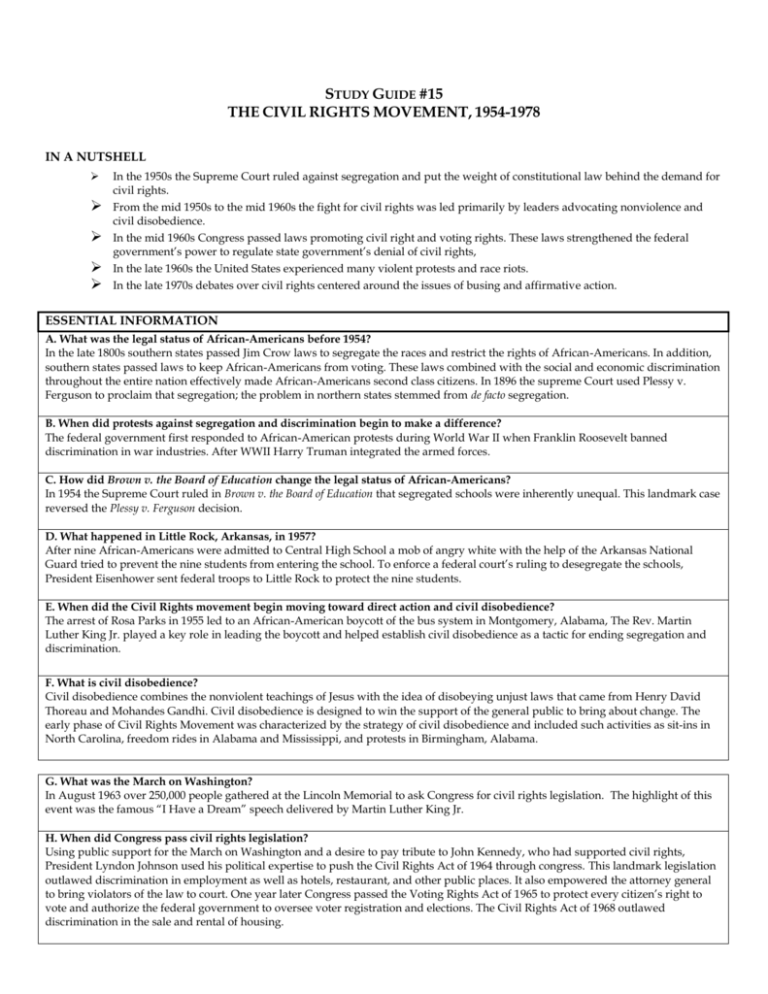
STUDY GUIDE #15 THE CIVIL RIGHTS MOVEMENT, 1954-1978 IN A NUTSHELL In the 1950s the Supreme Court ruled against segregation and put the weight of constitutional law behind the demand for civil rights. From the mid 1950s to the mid 1960s the fight for civil rights was led primarily by leaders advocating nonviolence and civil disobedience. In the mid 1960s Congress passed laws promoting civil right and voting rights. These laws strengthened the federal government’s power to regulate state government’s denial of civil rights, In the late 1960s the United States experienced many violent protests and race riots. In the late 1970s debates over civil rights centered around the issues of busing and affirmative action. ESSENTIAL INFORMATION A. What was the legal status of African-Americans before 1954? In the late 1800s southern states passed Jim Crow laws to segregate the races and restrict the rights of African-Americans. In addition, southern states passed laws to keep African-Americans from voting. These laws combined with the social and economic discrimination throughout the entire nation effectively made African-Americans second class citizens. In 1896 the supreme Court used Plessy v. Ferguson to proclaim that segregation; the problem in northern states stemmed from de facto segregation. B. When did protests against segregation and discrimination begin to make a difference? The federal government first responded to African-American protests during World War II when Franklin Roosevelt banned discrimination in war industries. After WWII Harry Truman integrated the armed forces. C. How did Brown v. the Board of Education change the legal status of African-Americans? In 1954 the Supreme Court ruled in Brown v. the Board of Education that segregated schools were inherently unequal. This landmark case reversed the Plessy v. Ferguson decision. D. What happened in Little Rock, Arkansas, in 1957? After nine African-Americans were admitted to Central High School a mob of angry white with the help of the Arkansas National Guard tried to prevent the nine students from entering the school. To enforce a federal court’s ruling to desegregate the schools, President Eisenhower sent federal troops to Little Rock to protect the nine students. E. When did the Civil Rights movement begin moving toward direct action and civil disobedience? The arrest of Rosa Parks in 1955 led to an African-American boycott of the bus system in Montgomery, Alabama, The Rev. Martin Luther King Jr. played a key role in leading the boycott and helped establish civil disobedience as a tactic for ending segregation and discrimination. F. What is civil disobedience? Civil disobedience combines the nonviolent teachings of Jesus with the idea of disobeying unjust laws that came from Henry David Thoreau and Mohandes Gandhi. Civil disobedience is designed to win the support of the general public to bring about change. The early phase of Civil Rights Movement was characterized by the strategy of civil disobedience and included such activities as sit-ins in North Carolina, freedom rides in Alabama and Mississippi, and protests in Birmingham, Alabama. G. What was the March on Washington? In August 1963 over 250,000 people gathered at the Lincoln Memorial to ask Congress for civil rights legislation. The highlight of this event was the famous “I Have a Dream” speech delivered by Martin Luther King Jr. H. When did Congress pass civil rights legislation? Using public support for the March on Washington and a desire to pay tribute to John Kennedy, who had supported civil rights, President Lyndon Johnson used his political expertise to push the Civil Rights Act of 1964 through congress. This landmark legislation outlawed discrimination in employment as well as hotels, restaurant, and other public places. It also empowered the attorney general to bring violators of the law to court. One year later Congress passed the Voting Rights Act of 1965 to protect every citizen’s right to vote and authorize the federal government to oversee voter registration and elections. The Civil Rights Act of 1968 outlawed discrimination in the sale and rental of housing. I. What happened to the Civil Rights Movement in the late 1960s? Civil Rights leaders such as Martin Luther King Jr. found themselves isolated by the increasing militancy in the African-American community. Beginning in Watts, California, in 1965 and continuing throughout the late 1960s and the U.S. experienced numerous race riots. J. What was the Nation of Islam? The Nation of Islam was an African-American organization led by Elijah Muhammad. Sometimes referred to as Black Muslims, members of the Nation of Islam called on African Americans to gain self-respect by staying sober and morally pure. Preaching racial separation, the Nation of Islam believed in maintaining racial separation and seizing freedom by any means necessary, including violence. An important spokesperson for the Nation of Islam was Malcolm X who left the Nation of Islam in 1964 and was assassinated in 1965. K. Who were the Black Panthers? In 1966 the Black Panther Party was organized to patrol the streets in the ghettos. In the late 1960s the Black Panther became an organization of revolutionaries who advocated using violence to draw attention to conditions in the ghettos. L. When was Martin Luther King Jr. assassinated? King, who had been planning a Poor People’s March on Washington, was assassinated in Memphis, Tennessee, on April 4, 1968. His assassination touched off rioting in over 150 cities. The rioting in Washington D.C. reached such an intensity that U.S. Troops had to surround the U.S. Capitol Building for the only time since the Civil War. M. What happened to the Civil Rights Movement after King’s assassination? Although by 1970 more than 15 years has passed since the Supreme Court first ordered desegregation of the schools, few African American children attended de segregated schools. To remedy this situation court-ordered busing was used at achieve racial integration. During the 1970s busing became a controversial issue in American politics. In addition to court ordered busing, affirmative action became a controversial issue in the 1970s. Although legal barriers to racial integration had been lifted, the effects of several generations of racial discrimination barred many people from enjoying opportunities traditionally reserved for white males. Accordingly, many institutions started taking affirmative action to bring minorities into their institutions. In 1978 The Supreme Court used the Bakke decision to state that schools could not give preference to members of any group on the basis of ethnic or racial identity alone. However, the Supreme Court also ruled that racial factors could be taken into account in a school’s overall admissions policy. SIGNIFICANT EVENTS: 1. Booker T Washington delivers Atlanta Compromise Speech, 1895 10. Mississippi Summer project, 1964 2. Plessy v. Ferguson, 1896 11. Civil Rights Act of 1964 3. Brown v. Board of Education, 1954 12. Malcolm X assassinated, 1965 4. Montgomery bus boycott, 1955 13. March from Selma to Montgomery, 1965 5. U.S. troops sent to Little Rock, 1957 14. Voting Rights Act of 1965 6. Greensboro sit-ins, 1960 15. Riots in Watts, California, 1965 7. Freedom Riders, 1961 16. Civil Rights Act of 1968 8. Birmingham, Alabama, 1963 17. Martin Luther King Jr. assassinated, 1968 9. March on Washington, 1963 18. Bakke decision, 1978 IMPORTANT PEOPLE: 19. Booker T. Washington 24. Malcolm X 20. W.E.B. DuBois 25. James Meredith 21. Rosa Parks 26. Stokely Carmichael 22. Martin Luther King Jr. 27. George Wallace 23. Elijah Muhammad 28. Thurgood Marshall ADDITIONAL INFORMATION: 29. Jim Crow Laws 34. SNCC 30. de jure segregation 35. Nation of Islam (Black Muslims) 31. de facto segregation 36. Black Panthers 32. SCLC 37. busing 33. CORE 38. affirmative action America is essentially a dream, a dream as yet unfulfilled. It is a dream of a land where men of all races, of all nationalities and of all creeds can live together as brothers. The substance if the dream is expressed in these sublime words, words lifted to cosmic proportions: “We hold these truths to be self evident, that all men are created equal, that they are endowed by their Creator with certain unalienable rights, that among these are life, liberty and the pursuit of happiness.” This is the dream. And there is another thing we see in this dream that ultimately distinguishes… our form of government from all the totalitarian regimes that emerge in history. It says that each individual has certain basic rights that are neither conferred by nor derived from the state. To discover where they came from it is necessary to move back behind the dim mist of eternity, for they are God-given. Very seldom if ever in the history of the world has a sociopolitical document expressed in such profoundly eloquent and unequivocal language the dignity and the worth of human personality. The American dream reminds us that every man is heir to the legacy of worthiness… -- Martin Luther King, Jr., 1961
